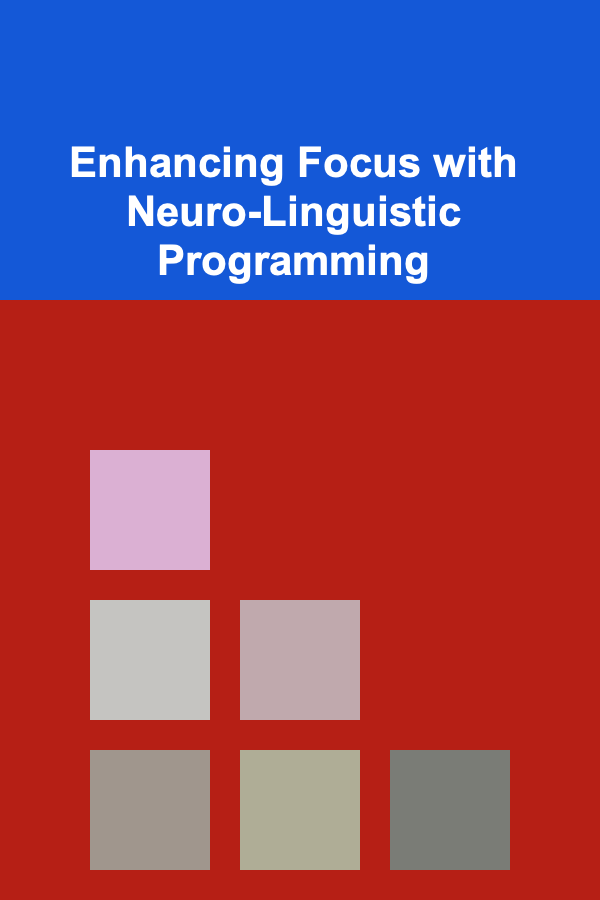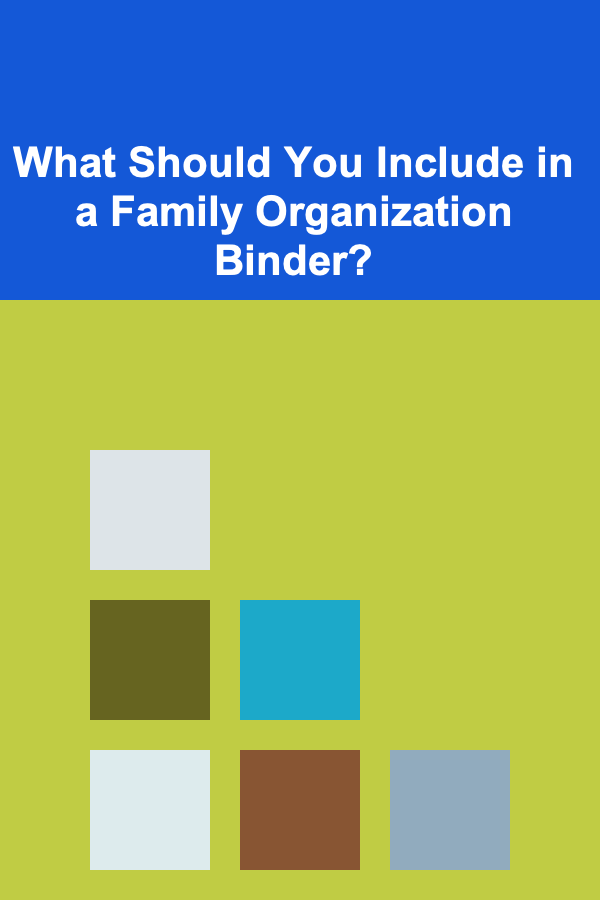
Enhancing Focus with Neuro-Linguistic Programming
ebook include PDF & Audio bundle (Micro Guide)
$12.99$9.99
Limited Time Offer! Order within the next:

In today's fast-paced world, where distractions abound and information overload is the norm, maintaining focus is more challenging than ever. The ability to concentrate, to single-mindedly pursue a goal, and to filter out irrelevant stimuli is a crucial skill for success in both personal and professional life. While various techniques and strategies promise to improve focus, Neuro-Linguistic Programming (NLP) offers a unique and powerful approach that delves into the underlying mechanisms of the mind. This article will explore how NLP can be effectively utilized to enhance focus, providing a comprehensive guide to understanding its principles and practical application.
Understanding Neuro-Linguistic Programming (NLP)
Before delving into the specific techniques for enhancing focus, it's essential to understand the core principles of NLP. NLP is a psychological approach that analyzes the strategies used by successful individuals and applies them to help others achieve similar outcomes. It's based on the idea that the way we think, communicate, and behave are interconnected and can be modeled and modified. The name itself provides insight into its components:
- Neuro: Refers to the neurological system, which processes experiences through our five senses. These sensory inputs form the foundation of our thoughts, feelings, and behaviors.
- Linguistic: Concerns the language we use to represent and interpret our experiences. Language, both verbal and nonverbal, shapes our understanding of the world and influences our actions.
- Programming: Describes the patterns of thoughts, feelings, and behaviors we develop over time. These patterns, often unconscious, dictate how we respond to different situations. NLP seeks to identify and reprogram these patterns to create more desirable outcomes.
At its heart, NLP is about understanding how we create our internal representations of reality and how we can consciously influence those representations to achieve our goals. It's a practical and results-oriented approach that emphasizes modeling excellence and empowering individuals to take control of their minds and behaviors.
The Link Between NLP and Focus
Focus, at its core, is about directing your attention and energy towards a specific task or goal while minimizing distractions. NLP provides a powerful framework for understanding and manipulating the internal processes that govern attention and concentration. Several key concepts within NLP directly relate to enhancing focus:
- Representational Systems (VAKOG): We process information through our five senses: Visual, Auditory, Kinesthetic, Olfactory, and Gustatory (VAKOG). Understanding your dominant representational system and how you use your senses to think can help you tailor your environment and internal processes to optimize focus. For example, a visual person might benefit from creating a visually stimulating workspace, while an auditory person might find background music helpful.
- Submodalities: These are the finer qualities of our sensory experiences. For example, within the visual representational system, submodalities include brightness, color, size, location, and movement. By manipulating these submodalities, we can change the intensity of our thoughts and feelings. This is particularly useful for managing distractions and enhancing motivation.
- Anchoring: Anchoring is the process of associating a specific stimulus (e.g., a touch, a word, or a visual image) with a particular state of mind (e.g., focus, confidence, or calm). By creating and triggering anchors, we can quickly access desired states of focus on demand.
- Reframing: This involves changing the way you perceive a situation or problem. By reframing distractions as opportunities for growth or learning, you can reduce their negative impact and maintain focus on your primary goal.
- Goal Setting: NLP emphasizes the importance of setting well-formed outcomes. A clearly defined, compelling goal acts as a powerful attractor, drawing your attention and energy towards its achievement and minimizing distractions.
NLP Techniques for Enhancing Focus
Now that we've established the connection between NLP and focus, let's explore specific NLP techniques that can be used to improve concentration and minimize distractions:
1. Identifying and Managing Distractions
The first step towards enhancing focus is to identify the specific distractions that are hindering your ability to concentrate. These distractions can be internal (e.g., wandering thoughts, anxieties, or physical discomfort) or external (e.g., noise, interruptions, or tempting notifications). Use the following exercises to pinpoint your common distractions:
- Distraction Journal: For a week, keep a journal and meticulously record every instance you lose focus. Note the time, the activity you were engaged in, the specific distraction (internal or external), and your reaction to it.
- Sensory Awareness: Throughout the day, consciously pay attention to your senses. What are you seeing, hearing, feeling, smelling, and tasting? This heightened awareness can help you identify subtle distractions that you might otherwise overlook.
Once you've identified your key distractions, use the following NLP techniques to manage them:
- Swish Pattern: This technique is particularly effective for managing unwanted thoughts or cravings that interrupt your focus.
- Identify the "cue picture": This is the internal image you see or feel just before you get distracted (e.g., the image of your phone, the feeling of boredom).
- Create a "desired picture": This is the image of yourself completely focused on your task, feeling productive and engaged. Make this image vivid, bright, and compelling.
- Practice the "swish": Simultaneously shrink the cue picture and make the desired picture larger, brighter, and closer. Imagine a "swish" sound as the pictures change. Repeat this process several times, each time making the swish faster and more powerful. Over time, the cue picture will become associated with the desired picture, and you'll find yourself automatically shifting your focus back to your task whenever a distraction arises.
- Dissociation: If you're experiencing negative thoughts or emotions that are distracting you, use dissociation to create some distance.
- Visualize yourself in a movie theater: Imagine yourself sitting in the audience, watching yourself on the screen experiencing the distracting thought or emotion.
- Create distance: Make the screen smaller, dimmer, and further away. You can also add a black and white filter.
- Step outside the theater: Imagine yourself leaving the theater and leaving the problem behind. By dissociating from the distracting experience, you can reduce its intensity and regain your focus.
- Anchoring for Relaxation: Create an anchor for relaxation and use it to calm yourself when you feel overwhelmed or anxious.
- Recall a time when you felt completely relaxed and peaceful: Relive the experience in detail, focusing on what you saw, heard, felt, smelled, and tasted.
- Choose a physical anchor: As you're experiencing the relaxed state, choose a specific touch, such as pressing your thumb and forefinger together.
- Repeat the process: Practice recalling the relaxed state and triggering the anchor several times. Whenever you feel distracted by anxiety or stress, trigger the relaxation anchor to quickly calm yourself and regain your focus.
2. Creating a Focused State
Beyond managing distractions, NLP can also be used to actively create a state of focus. These techniques help you to prime your mind and body for concentration:
- Visual Dissociation & Future Pacing: This technique builds upon the dissociation technique to create a compelling vision of focused success.
- Identify a Future Task: Choose a task you want to be more focused on completing.
- Visual Dissociation of Past Challenges: As before, visually dissociate from past experiences where you struggled to focus on similar tasks. Dim the image, make it distant, and emotionally detach from the experience.
- Future Pace with Focused Success: Now, step into the future and vividly imagine yourself successfully completing the chosen task with laser-like focus. See yourself effortlessly overcoming obstacles and achieving your goal. Engage all your senses: What do you see, hear, feel, and even smell and taste as you successfully complete the task?
- Anchor the Focused State: As you're experiencing this future success, choose a physical anchor, like a specific hand gesture or word, to lock in the feeling of focus.
- Test and Repeat: Practice triggering the anchor before beginning the task. Repeat the process regularly to strengthen the association between the anchor and the focused state.
- Using Representational Systems (VAKOG): Understand your dominant representational system and use it to enhance your focus.
- Visual: If you're primarily visual, create a visually stimulating workspace with clear goals and reminders. Use mind maps, diagrams, and visual cues to organize your thoughts and stay on track.
- Auditory: If you're primarily auditory, listen to instrumental music or white noise to block out distractions. Use affirmations or repeat your goals aloud to reinforce your focus.
- Kinesthetic: If you're primarily kinesthetic, take frequent breaks to move around and stretch. Use tactile objects, such as stress balls or fidget toys, to channel your energy and maintain focus.
- Using Submodalities for Motivation: Manipulate the submodalities of your internal representations to increase your motivation and focus.
- Imagine your goal: Create a vivid mental image of your goal.
- Enhance the submodalities: Make the image brighter, larger, closer, and more colorful. Add movement and sound.
- Step into the image: Imagine yourself stepping into the image and experiencing the feeling of achieving your goal. By enhancing the submodalities of your goal, you can increase its attractiveness and make it more compelling, thereby boosting your motivation and focus.
- Creating a "Focus Zone": Designate a specific physical space as your "focus zone." This space should be free of distractions and associated solely with productive work.
- Clear the clutter: Remove any unnecessary items from your workspace.
- Optimize the environment: Adjust the lighting, temperature, and noise level to create a comfortable and conducive environment.
- Establish a routine: Develop a routine that signals to your brain that it's time to focus (e.g., sitting in your designated chair, putting on headphones, taking a deep breath). Over time, your brain will associate the "focus zone" with concentration, making it easier to enter a focused state whenever you're in that space.
3. Setting Well-Formed Outcomes
A clearly defined and compelling goal is a powerful driver of focus. NLP emphasizes the importance of setting "well-formed outcomes," which are goals that are specific, measurable, achievable, relevant, and time-bound (SMART), and also ecologically sound.
- Specific: Clearly define what you want to achieve. Avoid vague or ambiguous goals.
- Measurable: How will you know when you've achieved your goal? Define specific metrics or indicators.
- Achievable: Is your goal realistic and attainable given your resources and skills?
- Relevant: Is your goal aligned with your values and priorities?
- Time-bound: When do you want to achieve your goal? Set a specific deadline.
- Ecologically Sound: Consider the impact of achieving your goal on other areas of your life and ensure that it's congruent with your values and relationships. Will achieving this goal negatively impact anything else important to you?
By setting well-formed outcomes, you create a clear roadmap for your actions and provide a powerful motivation to stay focused on your goals. Consider the following examples:
- Poorly Formed Outcome: "I want to be more focused."
- Well-Formed Outcome: "I will complete the first draft of my report by Friday at 5 PM by working in my designated focus zone for 2 hours each day, minimizing distractions by turning off notifications and using the 'swish pattern' technique when my mind wanders. I will reward myself with a 30-minute walk after each focused session."
The well-formed outcome is much more likely to lead to success because it provides specific guidance and motivation.
4. Reframing Challenges and Setbacks
Setbacks and challenges are inevitable, but how you respond to them can significantly impact your ability to maintain focus. NLP provides techniques for reframing these experiences to minimize their negative impact and even turn them into opportunities for growth.
- Reframing the Meaning: Change the way you interpret a setback. Instead of viewing it as a failure, consider it a learning opportunity. Ask yourself: "What can I learn from this experience?" "How can I use this information to improve my performance in the future?"
- Reframing the Context: Change the context in which you view a setback. Consider the bigger picture. Is this setback truly significant in the grand scheme of things? Often, setbacks appear less daunting when viewed from a broader perspective.
- "As If" Frame: Act "as if" you are already focused and successful, even when you don't feel like it. Adopt the posture, body language, and mindset of someone who is highly focused and productive. This can create a self-fulfilling prophecy, leading you to actually become more focused.
By reframing challenges and setbacks, you can maintain a positive and resilient mindset, which is crucial for sustaining focus over the long term.
Integrating NLP into Your Daily Life
The key to effectively using NLP for enhancing focus is to integrate these techniques into your daily life. Here are some practical tips:
- Start Small: Don't try to implement all the techniques at once. Start with one or two that resonate with you and gradually add more as you become comfortable.
- Practice Regularly: Consistency is key. Make a conscious effort to practice these techniques every day, even when you don't feel particularly distracted. The more you practice, the more automatic they will become.
- Be Patient: It takes time and effort to develop new habits and reprogram your mind. Don't get discouraged if you don't see results immediately. Keep practicing, and you will eventually see significant improvements in your focus and concentration.
- Seek Support: Consider working with an NLP practitioner or coach who can provide personalized guidance and support. They can help you identify your specific challenges and develop strategies that are tailored to your individual needs.
Conclusion
Enhancing focus is an ongoing process that requires conscious effort and dedication. Neuro-Linguistic Programming offers a powerful set of tools and techniques for understanding and manipulating the internal processes that govern attention and concentration. By identifying and managing distractions, creating a focused state, setting well-formed outcomes, and reframing challenges, you can significantly improve your ability to concentrate and achieve your goals. Remember that NLP is not a magic bullet, but a set of practical tools that, when applied consistently and strategically, can lead to remarkable improvements in your focus and overall performance. Embrace the journey of self-discovery and empowerment that NLP offers, and unlock your full potential for focus and success.

Creating a Digital Journal for Writers
Read More
How to Decorate Your Entryway Without Overspending
Read More
How to Use Shelving Units to Enhance Bathroom Storage
Read More
What Should You Include in a Family Organization Binder?
Read More
How to Cook Healthy Slow Cooker Meals for Weight Loss
Read More
Yoga for Weight Loss and Stress Relief: A Comprehensive Guide
Read MoreOther Products

Creating a Digital Journal for Writers
Read More
How to Decorate Your Entryway Without Overspending
Read More
How to Use Shelving Units to Enhance Bathroom Storage
Read More
What Should You Include in a Family Organization Binder?
Read More
How to Cook Healthy Slow Cooker Meals for Weight Loss
Read More